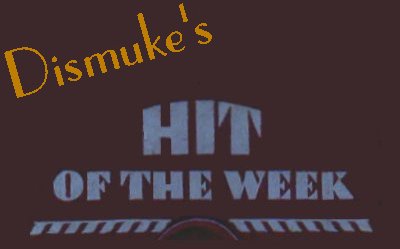

December 2002
December 19, 2002
This week's Hit of the Week is brought
to you by
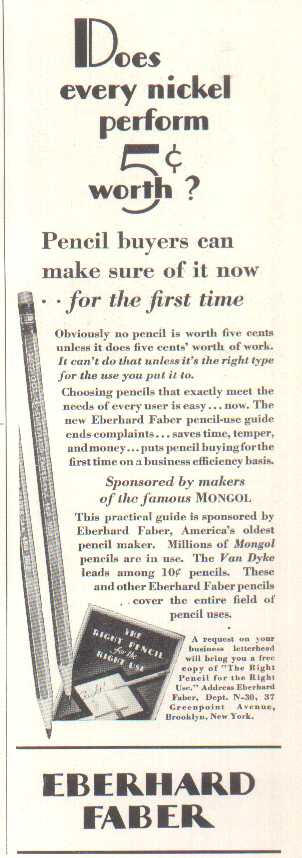
(from circa 1929ad)
Why
Do You Suppose?
Nat Shilkret and His Victor Orchestra
Franklyn Baur, vocal
1929
(Victor 22204 - B)
Here is a record that I picked up
a month or two ago in a small town antique shop. It is a bit noisy
during the vocal passage, but still quite listenable. The song was
written by Rodgers and Hart and is from the musical comedy Heads Up.
December 12, 2002
This week's Hit of the Week is brought
to you by
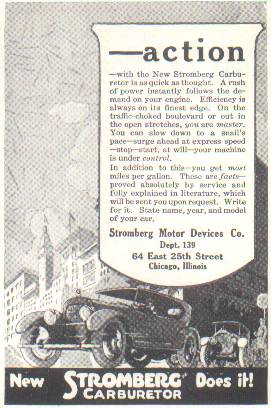
Stromberg Carburetor
(from circa 1922 ad)
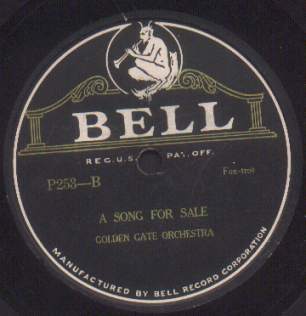
A
Song For Sale
Golden Gate Orchestra
1923
(Bell P253-B)
This week's selection is from an
acoustically recorded Bell record. Bell records were issued between
1920 and 1928 and were sold through the W.T. Grant dime store chain.
I've always thought that the Bell label's drawing of a horn playing devil
made it one of the more attractive and interesting looking labels of the
period.
On this week's selection, "Golden
Gate Orchestra" was a recording pseudonym for the California Ramblers (the
Harry Reser band also made recordings under that pseudonym). The
New York based California Ramblers was one of the early "hot" white jazz
bands. The band's personnel changed over the years, but included
for a time such famous names as Adrian Rollini, Jimmy and Tommy Dorsey,
Red Nichols and Glenn Miller. The band made records under a number
of pseudonyms for most of the record labels in business during the 1920s.
My understanding is that the California Ramblers ceased to exist as a band
around 1929 - though the name was used in various recording sessions through
about 1935.
This week's selection was recorded
November 24, 1923. A few weeks earlier, on November 5, the Ramblers
made a different recording of the same song which was released on a number
of labels. On the Paramount and Puritan releases, the band
was identified as the "Golden Gate Orchestra." On the Claxtonola and Harmograph
releases, the band was listed as being the "The Broadway Music Masters."
On the Radiex release, however, the band was billed under its real name.
December 5, 2002
This week's Hit of the Week is brought
to you by
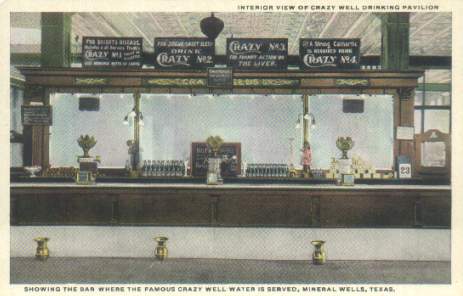
Interior View of Crazy Well Drinking Pavilion
Showing The Bar Where The Famous Crazy Well Water
Is Served
Mineral Wells, Texas
For Bright's Disease, Diabetes
or all Nervous Trouble,
CRAZY No.
1
cannot be surpassed.
BEST MINERAL WATER ON EARTH.
- - - - -
For Sound Sweet Sleep
DRINK
CRAZY No.
2
- - - - -
CRAZY No.
3
For Prompt Action on THE LIVER
- - - - -
When A Strong Cathartic Is Required
DRINK
CRAZY No.
4
|
(from circa 1920 postcard)
Sometime
- Medley
Joseph C. Smith's Orchestra
1919
(Victor 35684-A)
Joseph C.Smith's Orchestra was the
Victor Talking Machine Company's most successful band for popular dance
records in the late 1910s. Featuring string instruments and piano,
the band's sound was, at the time, considered fresh and modern compared
with the military bands the record companies previously used to present
dance music. But by the early 1920s, the rise of larger and jazzier
sounding bands such as the Paul Whiteman Orchestra quickly made Smith's
recordings sound old fashioned by comparison and his popularity faded.
His last recordings for Victor were made in 1922. After he left Victor,
he recorded without much success for the Brunswick label. His final recordings
were made in Canada for the HMV label in early 1925. More detailed
information on the rise and fall of the Smith band can be found in this
article.
This recording is slightly longer
than most presented here because it is from a 12 inch 78 rpm as opposed
to the 10 inch size more commonly used on popular recordings. This
selection is very typical of instrumental dance recordings of the
period - a time when ragtime was on the verge of giving way to jazz.
One very beneficial development that came with the jazz era was more elaborate
and imaginative musical arrangements. Before the 1920s, recorded
dance music tended to be played "straight" from the published sheet music.
Jazz provided a greater freedom to make changes which extended not only
to the improvised solos featured by the more jazz oriented dance
bands but to the bands' arrangers as well. Previously,
if a song was not long enough to fill an entire side of a record, the arranger
would simply repeat certain passages over again with only limited variation.
Because of this, recordings of even interesting songs from the period can
be a bit tedious to listen to. My guess is that this at least partially
explains why so many early dance records featured medleys - as does this
week's selection. The other tunes featured in the recording are "The
Tune You Can't Forget," "Any Kind of Man" and "Keep on Smiling."
Despite having four songs, however, the recording has many repeated passages
and one gets the feeling that the guiding premise was something along the
lines of : "How much time do we have to fill? - what can we do to stretch
this out a bit?"

|


